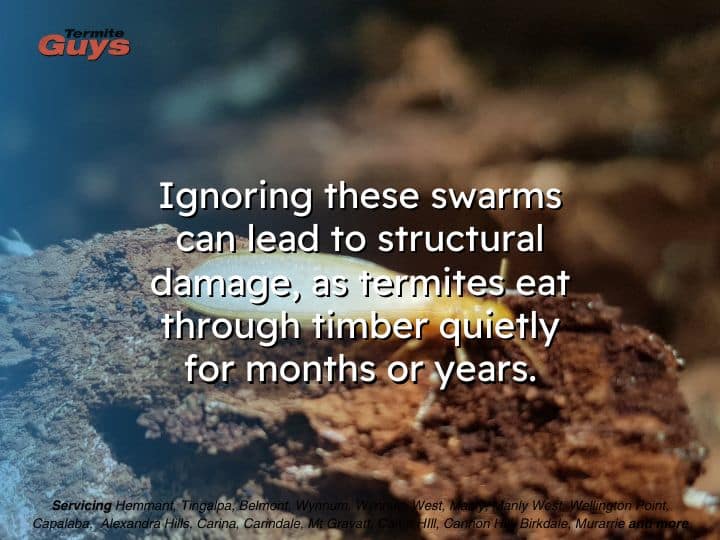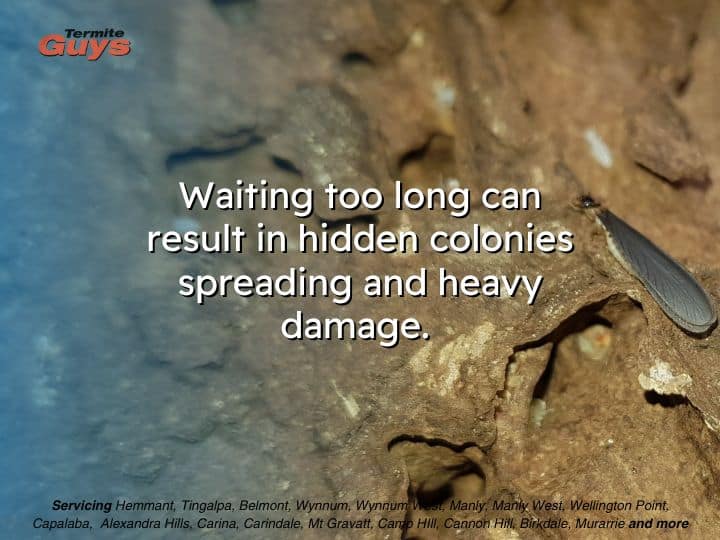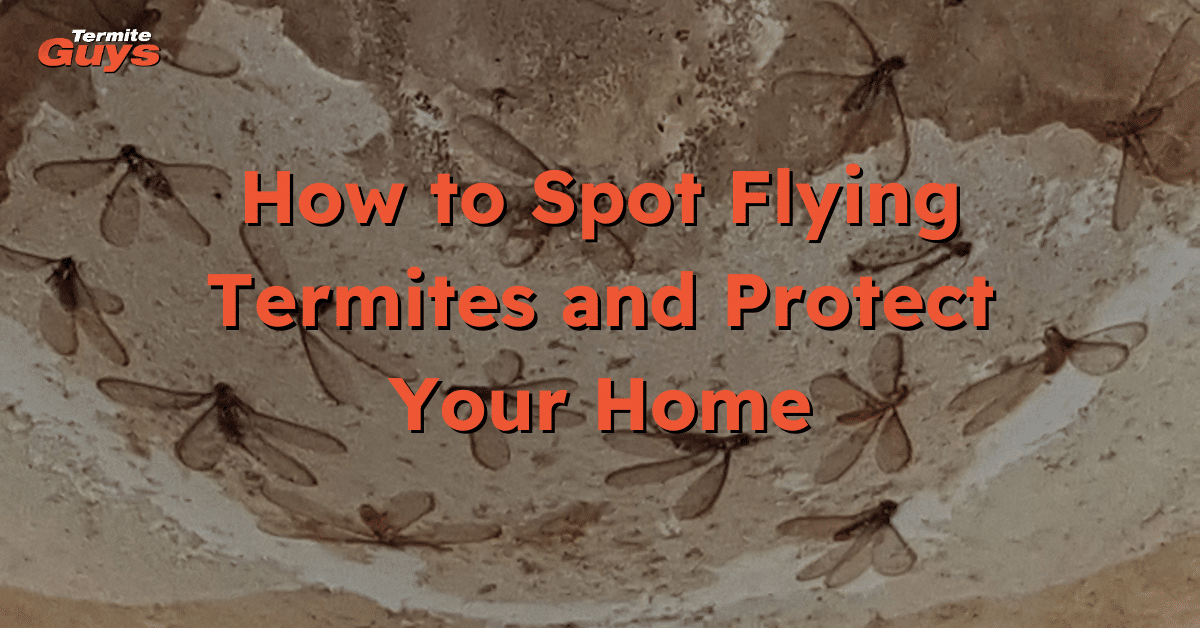Flying termites are often the first sign that a hidden colony is lurking nearby – and for Brisbane homeowners, overlooking these tiny invaders can mean expensive repairs and compromised safety. Learning how to spot flying termites and acting quickly is essential to keeping your most valuable investment secure.
Spotting swarms or discovering piles of tiny wings isn’t just an inconvenience: it’s a signal that your property could be the next target for one of Queensland’s most destructive pests. Residents in Brisbane should be vigilant – especially during spring and summer – by inspecting vulnerable areas, acting when suspicious signs appear, and leveraging professional expertise.
Who Do You Call If You See Flying Termites Around Your Home
Call Termite Guys Brisbane on 07-33933515 if you see termites swarming in Brisbane during October or November, it’s a serious warning sign that a nest is nearby.
Flying termites are nature’s way of telling you your home could soon be at risk. The best prevention is installing a professional termite barrier to keep them out. That’s why calling Termite Guys Brisbane is so important. Don’t wait until damage occurs – act now. Call 07-3393-3515 or email admin@termiteguys.com.au
Key takeaways
Flying termites indicate nearby colonies ready to expand.
Shed wings and swarms near lights mean active infestation risk.
Rapid response can prevent costly damage and structural loss.
How Can You Recognise Flying Termites in Brisbane?
Identifying flying termites early can make all the difference in preventing damage to your Brisbane home. These pests, also called alates, take flight during humid months and are often seen near windows, doors, and lights at dusk. Alates have a cigar-shaped body, grey or gold wings, and shed their wings when starting a new colony.
Winged termites are easily mistaken for flying ants, but key differences set them apart. Unlike ants, termites have straight antennae, broad waists, and wings of equal size. Noticing these features – and piles of translucent wings – should prompt immediate action in any Brisbane home.
Flying termites swarm during Brisbane’s humid months (October-March).
Termite alates are attracted to light and found near window sills and doors.
Uniform, shed wings signal new colony formation nearby.
Termites have straight antennae, broad bodies, and wings of equal length.
Flying termite swarms at night often mean a mature colony is close by.
Commonly asked questions
What are the signs of flying termites in Brisbane?
The main signs include swarms near lights, discarded wings by windows, and small holes or damaged wood around your home. Spotting these is an urgent signal to investigate further or call specialists.
How do flying termites differ from flying ants?
Flying termites have straight antennae, broad waists, and wings of equal length, while flying ants have bent antennae, pinched waists, and uneven wings. This visual difference makes identification straightforward for Brisbane residents.
Why Is Spotting Flying Termites Important for Brisbane Homeowners?
Seeing flying termites may seem harmless, but for Brisbane homeowners it’s a critical alarm: a mature colony is looking to expand, and your home may be its next target. Only winged termites – also known as alates – leave their nests to mate and start new colonies when conditions are ideal. Quick action can stop an infestation before costly damage occurs.
Ignoring these swarms can lead to structural damage, as termites eat through timber quietly for months or years.
Queensland’s climate creates a perfect breeding ground, especially after storms when humidity spikes and swarms move in.

Flying termites are a red flag for a nearby mature colony.
Their presence often means hidden termites are already damaging your property.
Brisbane’s humid weather increases flying termite swarms in spring/summer.
Established alates quickly find damp areas of timber to begin new colonies.
Termites silently destroy timber, risking thousands in repairs.
Questions relating to spotting termites
Why are flying termites a problem for Brisbane homes?
Flying termites mean a mature colony is ready to expand. Their presence signals high risk of hidden damage and rapid future infestations if ignored.
Can flying termites cause damage themselves?
Alates don’t eat timber, but they create new nests – leading to worker termites that are responsible for serious structural damage in Brisbane properties.
How Do Experts Inspect for Flying Termites in Brisbane?
Professional termite inspections in Brisbane use advanced tools to detect colonies, even when signs are almost invisible to homeowners. Inspectors rely on moisture meters, thermal imaging, and movement-detection devices to spot active termites and assess home risk accurately.
Expert inspections cover all common entry points and timber structures, looking for hollow-sounding beams, mud tubes, and other subtle evidence. Professionals also provide clear, detailed reports with recommended treatments or barriers.
What you can expect when professionals look at your property:
Brisbane inspectors utilise thermal imaging to find hidden colonies.
Moisture meters detect termite-friendly damp spots in timber.
Movement sensors can pinpoint termite activity behind walls.
Full checks include roof voids, subfloors, gardens and fences.
Detailed written reports guide homeowners on risk and protecting their property.
Questions asked about termite professionals
What technology do Brisbane inspectors use for termites?
Professionals use thermal cameras, moisture meters, and movement detectors to find hidden termites and assess the level of infestation. This equipment ensures no colony goes unnoticed in a Brisbane inspection.
How thorough are professional termite inspections?
Inspections cover all property areas, including attics, subfloors, gardens, and fences. Brisbane specialists create detailed reports with photos and tailored recommendations for protection and treatment.
What DIY Steps Can Brisbane Residents Take to Spot Flying Termites Early?
While expert inspections are best for finding hidden threats, Brisbane homeowners can perform simple checks to spot flying termites and prevent infestations before they escalate. The most effective approach is regular visual inspection for wings, mud tubes, and wood damage, especially after rains or storms.
Tapping on timber to listen for hollow sounds and inspecting foundations for mud tubes are easy, yet powerful, DIY methods. Removing sources of moisture and keeping wood away from the house further reduces risk.
Inspect windows, doors, and sills for piles of shed wings regularly.
Tap wood beams and furniture to check for hollow sounds, indicating internal damage.
Look for mud tubes around foundations and under house edges.
Move timber debris and wood piles away from the building’s perimeter.
Address leaks and drainage issues for a dry, termite-unfriendly environment.
Commonly asked questions
Can I check for flying termites myself?
Yes—visually inspect timber, tap beams for hollow sounds, and look for piles of wings, mud tubes or small holes. Early detection allows Brisbane residents to act before severe damage occurs.
Are DIY inspections enough for Brisbane homes?
DIY checks are useful for quick detection, but professional inspections use technology to catch hidden termites and provide lasting protection. Brisbane’s climate demands both approaches for full safety.
When Should You Call Brisbane Professionals for Termite Control?
Noticing flying termites, shed wings, or mud tubes should prompt immediate assistance from Brisbane experts for thorough inspection and safe, targeted treatment. Waiting too long can result in hidden colonies spreading and heavy damage. Professional pest control is essential for putting robust protective barriers in place and responding with licensed techniques.
Brisbane humidity means termite risks can change rapidly, especially after storms.
Specialists from Termite Guys Brisbane are experienced in local conditions – offering prompt inspections, detailed reports, and proven treatment plans that keep homes secure.

Tips To Help Homeowners!
Call immediately if swarms, wings, or mud tubes are found.
Licensed experts act quickly to prevent further spread or damage.
Professional treatments create effective long-term barriers against termites.
Local knowledge enables tailored solutions for Queensland homes.
Peace of mind comes with expert inspections, proven protection, and support.
Commonly asked questions
When is it necessary to contact termite specialists in Brisbane?
If flying termites, shed wings, or damaged timber appear, call licensed Brisbane professionals for inspections and treatment. Expertise ensures safety and long-term protection.
How do Brisbane experts remove termite threats?
Termite Guys Brisbane use advanced detection, targeted treatments, and durable barriers. Their team responds quickly and offers peace of mind throughout Brisbane suburbs.
How Do You Protect Your Home from Flying Termites in Brisbane Long-Term?
Protecting a Brisbane home means persistent vigilance and regular professional inspections to prevent new colonies from forming. Combining annual expert checks and strong barriers, with DIY prevention and home maintenance, offers the best chance at a termite-free property.
Managing moisture and wood storage, scheduling inspections after storms, and keeping garden areas dry are vital ongoing practices for Brisbane residents.
Useful tips to follow:
Schedule annual inspections with Brisbane specialists, especially after storms.
Install termite barriers during renovations or after initial treatment.
Keep foundation areas dry and move wood away from the building.
Maintain garden beds with regular checks for mud tubes or wing piles.
Address leaks, drainage and humidity issues inside and outside your house.
Engage professionals for treatment and advice on upgrades and repairs.
Common questions around termite inspections
How often should Brisbane homes be inspected for termites?
Annual inspections are recommended, with extra checks after storms or renovations. Regular visits from professionals help catch threats early and prevent major infestations in Brisbane homes.
What maintenance helps prevent flying termites?
Keep homes dry with well-maintained gutters and drainage, move timber away from house edges, and schedule professional inspections every year for the best protection in Brisbane.
Frequently Asked Questions
Q1: Do flying termites bite or sting Brisbane homeowners?
Flying termites do not bite or sting humans; their threat lies in creating new colonies that destroy timber and structural elements of homes.
Q2: Can I get rid of termites with DIY sprays in Brisbane?
DIY sprays are ineffective against established colonies. Only licensed treatments from professionals guarantee full eradication and long-term protection in Brisbane.
Q3: What’s the difference between flying termites and flying ants?
Flying termites have broad waists, straight antennae, and equal-length wings – while ants have narrow waists, bent antennae, and uneven wings.
Q4: How quickly can termites damage a Brisbane house?
Termites are silent destroyers and may cause major structural damage within months, especially if undetected.
Q5: Is a single flying termite cause for alarm?
Spotting one alate may indicate a nearby colony. It’s safest to schedule a professional inspection to rule out a developing infestation.
Summary:
Knowing How to Spot Flying Termites and Protect Your Home is vital for Brisbane residents, especially during warm and humid months. Spot swarms, look for wings, and act fast – Termite Guys Brisbane are the trusted specialists for thorough inspections and termite control, delivering peace of mind and proven protection for every home.


